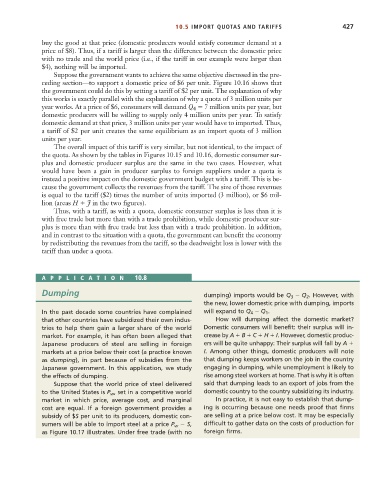Page 453 - Microeconomics, Fourth Edition
P. 453
c10competitive markets applications.qxd 7/15/10 4:58 PM Page 427
10.5 IMPORT QUOTAS AND TARIFFS 427
buy the good at that price (domestic producers would satisfy consumer demand at a
price of $8). Thus, if a tariff is larger than the difference between the domestic price
with no trade and the world price (i.e., if the tariff in our example were larger than
$4), nothing will be imported.
Suppose the government wants to achieve the same objective discussed in the pre-
ceding section—to support a domestic price of $6 per unit. Figure 10.16 shows that
the government could do this by setting a tariff of $2 per unit. The explanation of why
this works is exactly parallel with the explanation of why a quota of 3 million units per
year works. At a price of $6, consumers will demand Q 4 7 million units per year, but
domestic producers will be willing to supply only 4 million units per year. To satisfy
domestic demand at that price, 3 million units per year would have to imported. Thus,
a tariff of $2 per unit creates the same equilibrium as an import quota of 3 million
units per year.
The overall impact of this tariff is very similar, but not identical, to the impact of
the quota. As shown by the tables in Figures 10.15 and 10.16, domestic consumer sur-
plus and domestic producer surplus are the same in the two cases. However, what
would have been a gain in producer surplus to foreign suppliers under a quota is
instead a positive impact on the domestic government budget with a tariff. This is be-
cause the government collects the revenues from the tariff. The size of those revenues
is equal to the tariff ($2) times the number of units imported (3 million), or $6 mil-
lion (areas H J in the two figures).
Thus, with a tariff, as with a quota, domestic consumer surplus is less than it is
with free trade but more than with a trade prohibition, while domestic producer sur-
plus is more than with free trade but less than with a trade prohibition. In addition,
and in contrast to the situation with a quota, the government can benefit the economy
by redistributing the revenues from the tariff, so the deadweight loss is lower with the
tariff than under a quota.
APPLICA TION 10.8
Dumping dumping) imports would be Q 3 Q 2 . However, with
the new, lower domestic price with dumping, imports
In the past decade some countries have complained will expand to Q 4 Q 1 .
that other countries have subsidized their own indus- How will dumping affect the domestic market?
tries to help them gain a larger share of the world Domestic consumers will benefit: their surplus will in-
market. For example, it has often been alleged that crease by A B C H I. However, domestic produc-
Japanese producers of steel are selling in foreign ers will be quite unhappy: Their surplus will fall by A
markets at a price below their cost (a practice known I. Among other things, domestic producers will note
as dumping), in part because of subsidies from the that dumping keeps workers on the job in the country
Japanese government. In this application, we study engaging in dumping, while unemployment is likely to
the effects of dumping. rise among steel workers at home. That is why it is often
Suppose that the world price of steel delivered said that dumping leads to an export of jobs from the
to the United States is P w , set in a competitive world domestic country to the country subsidizing its industry.
market in which price, average cost, and marginal In practice, it is not easy to establish that dump-
cost are equal. If a foreign government provides a ing is occurring because one needs proof that firms
subsidy of $S per unit to its producers, domestic con- are selling at a price below cost. It may be especially
sumers will be able to import steel at a price P w S, difficult to gather data on the costs of production for
as Figure 10.17 illustrates. Under free trade (with no foreign firms.

